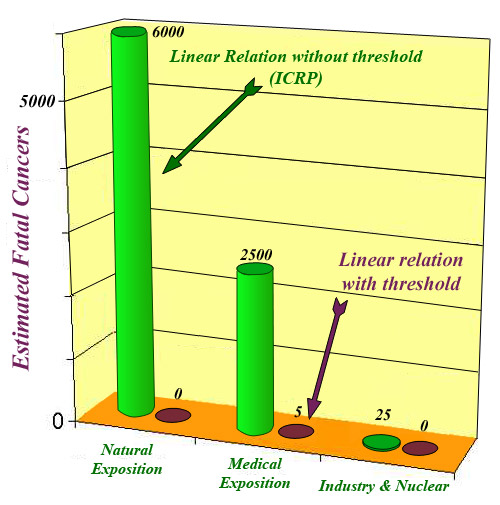Do low doses of radiation have any effect?
Radioprotection experts commonly refer to doses below one hundred millisieverts as ‘low’ and those below ten millisieverts (mSv) as ‘very low’. 100 mSv may seem a high cut-off point for ‘low doses‘, but no negative effects have been observed in adults for effective doses under 200 mSv and in children at dose under 100 mSv.

Implications of a threshold effect
Estimates of potentially fatal cancers resulting from exposure to radiation vary considerably. According to the ICRP proportionality relationship between dose and effect, even the tiniest doses could lead to fatalities. According to this linear rule, exposure to natural radioactivity (an average of 2.5 mSv per persons per year), medical exams (1 mSv) or nuclear industry (0.010 mSv) could cause thousands of deaths in France. If however, these ionising radiations are harmless below a threshold of 1 or 2 hundred millisieverts, the total number of deaths would be practically 0. Advanced models propose a reduction in risk for small doses.
© IN2P3
The absence of proved observations does not mean an absence of effects of ionizing radiation. It means that these effects are not significant enough to be observed in the usual way. In an attempt to estimate the effects at doses below 100 mSv, radioprotection experts make assumptions that are valid for higher doses and extend them into the range of low and very low exposure. Understanding this vast range – anything from 0.01 mSv to 100 mSv – is of paramount importance to us as these are the doses we encounter in daily life.
Advanced techniques such as immunofluorescence have measured an increase of « double strand breaks » in the DNA of living cells after a scanner. These double breaks are frequent and have many other sources that exposure to radiation. Most of the time they are repaired, but some improper repairs may transform normal cells into cancerous cells. The link between this radiosensitivity and the risk of cancer is unfortunately not known.
To return to the risk of « radiation-induced » cancers, this risk is certainly zero when the dose is zero.: on the graph representing the effects versus doses the curve passes through the origin of coordinates. For larges doses, the information available to experts is the data obtained from the heavily irradiated survivors of Hiroshima and Nagasaki. In the 1960s, the International Commission for Radiological Protection (ICRP) connected these two distant points on the graph with a straight line and defined this straight line as the relation betwenn the effects and the doses.
The ICRP graph does not represent a law of nature but rather a valuable tool created from the lack of available data. As a result, it must be used with care. Some radiobiologists today think that the ICRP pessimistic conclusions need to be reviewed, believing that our bodies’ natural repair mechanisms (DNA reparation, removal of damaged cells from the genome) can effectively limit the damage radiation causes at low doses. They propose that doses of radiation have no effect below a certain threshold value, and only start having consequences for our health when they exceed this level.
We currently have no way of determining the precise value of this threshold, though a number of biologists believe it lies at around 100 mSv.
The existence of a threshold effect would have important consequences for the way we handle weak doses of radiation. The question is one which sparks off lively debate. There is more than scientific accuracy at stake, An example may be given : of the 340,000 Chernobyl evacuees who absorbed an average of 30 mSv, the ICRP’s straight line graph predicts that 510 of them will die from radiation-induced cancers. If a threshold exists somewhere between 50 and 100 mSv, however, then the number who will die may very well be close to 0. In the same way and according to the ICRP, getting an X-ray scan or living in the granitic French Massif-Central mountains can be potentially fatal despite to the low levels of radiation involved. If a threshold exists, however, then the risks do not exist.
Other articles on the subject « Radiation Effects »
Deterministic effects
The domain of strong doses and severe, reproducible effects For high doses above a certain thresh[...]
Probabilistic effects
The domain of low and average doses For weak or medium-strength doses, the effects are not as cle[...]
Dose-effects Relationship
Can effects caused by low doses of radiations be predicted ? Even though we are constantly expose[...]
Cumulative Dose
What is the cumulative exposure? We receive an average of 2.5 millisieverts (mSv) per year from n[...]
Dose Rate
Acute and chronic exposures The « effective dose » is not sufficient by itself to characterize on[...]
Hiroshima Nagasaki Survivors
An exces of cancers and leukaemia among survivors Our knowledge of the risks of cancers due to ra[...]
Linear No-threshold Model
A Precautionary Principle applied to radioactivity … Is it possible to predict the effects [...]
Radiosensitivity
Sensitivity of DNA in living cells to radiation Although we still know little about the effects o[...]
Radioactive Toxicity
A useful indicator but to be used appropriately … The danger presented by a radioactive sub[...]
Dose Factors
What doses when swallowing or inhaling radioactive atoms ? How to evaluate the doses resulting fr[...]